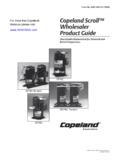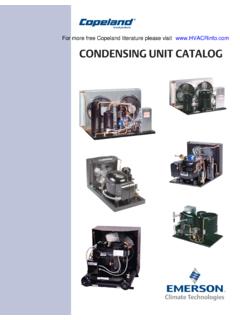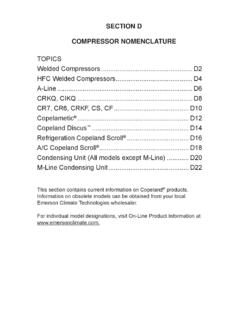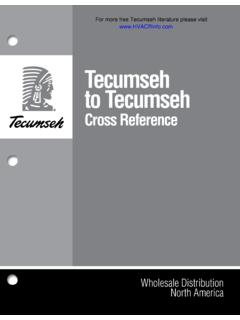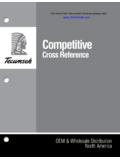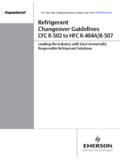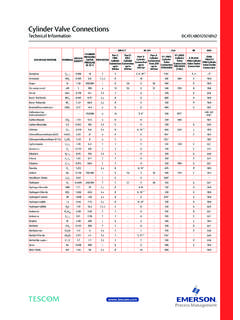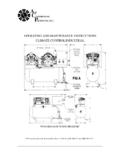Transcription of Refrigeration Manual - HVAC
1 Refrigeration Manual Part 5 - Installation and Service 1970 emerson Climate Technologies, Inc. All rights reserved. This is the fifth and last of a series of publications comprising the emerson Climate Tech- nologies, Inc. Refrigeration Manual . Part 1 Fundamentals of Refrigeration Part 2 Refrigeration System Components Part 3 The Refrigeration Load Part 4 System Design Part 5 Installation and Service The installation and service information is intended as a guide to good installation practice, and as an aid in analyzing system malfunctions. The section on service fundamentals is designed to serve as an introduction to various service procedures for beginning service men, students, salesmen, and others, needing a basic understanding of service tech- niques. 1970 emerson Climate Technologies, Inc. All rights reserved. Part 5. INSTALLATION AND SERVICE. Section 24. INSTALLATION Section 26. FUNDAMENTALS OF SERVICE. OPERATION. Recommended Installation Fundamentals of Evacuation and Handling of Refrigerant Safe Handling of Compressed Gases Brazing Connections on Welded When Testing or Cleaning Motor Refrigeration Installation of Suction and Discharge Handling Copper Line Vibration Brazing Refrigerant Typical Installation Service The Gauge Section 25.
2 SERVICING COPELAND Purging BRAND COMPRESSORS System Refrigerant Nameplate Identification of Port Locations in Charging Refrigerant into a Heads of Copelametic Removing Refrigerant from a Handling Refrigeration Identification of Motor Terminals on Determining the Oil Single Phase Adding Oil to a Proper Valve Plate and Head Gaskets Removing Oil from a for 3, 4, and 6 Cylinder Handling Compressor Burnouts What to Copeland Brand Oil Compressor Failures That Could Typical Copelametic Compressor Have Been Preventive Maintenance Accessibility on Copelametic Section 27. USEFUL ENGINEERING DATA. Field 1970 emerson Climate Technologies, Inc. All rights reserved. INDEX OF TABLES. Table 49 Boiling Point of Water at Varying Table 50 Comparison of Gauge and Absolute Pressures at Varying Table 51 Melting Points of Typical Commercial Brazing Table 52 Service Diagnosis Table 53 Temperature Table 54 International Rating Table 55 Thermal Table 56 Fahrenheit Centigrade Temperature Conversion Table 57 Properties of Saturated Table 58 Decimal Equivalents, Areas, and Circumferences of Table 59 Conversion Table Inches into Table 60 Conversion Table Decimals of an Inch into Table 61 Conversion Table Millimeters into Table 62 Conversion Table Hundredths of Millimeter into Table 63 Metric Table 64 Table 65 Table 66 Weight, Table 67 Volume, Table 68 Volume, Table 69 Table 70 Table 71 Table 72 Heat, Energy, Table 73 Solid and Liquid Expendable 1970 emerson Climate Technologies, Inc.
3 All rights reserved. Section 24. INSTALLATION. Recommended Installation Handling and Receiving of Equipment Procedures Responsibility should be assigned to a dependable It is quite probable that a majority of operating individual at the job site to receive material. Each failures on field installed systems can be traced shipment should be carefully checked against the to careless or inadequate installation procedures. bill of lading. The shipping receipt should not be The following instructions have been prepared to signed until all items listed on the bill of lading have help the installation and/or service engineer sys- been accounted for. tematically cover the many points which must be considered to provide each installation with trouble Check carefully for concealed damage. Any short- free performance. age or damages should be reported to the delivering carrier. Damaged material becomes the delivering These instructions are general in nature, and have carrier's responsibility, and should not be returned been primarily for field installed and connected sys- to the manufacturer unless prior approval is given tems normally utilizing compressors 2 horsepower to do so.
4 In size or larger. However, the procedures can be applied to almost any type of field installed system, When uncrating, care should be taken to prevent utilizing only those procedures which apply to the damage. Heavy equipment should be left on its specific installation. shipping base until it has been moved to the final location. Design and Application The packing list included with each shipment should A location for the compressor should be selected be carefully checked to determine if all parts and which provides good ventilation, even when re- equipment have been received. Any accessories mote condensers are to be used, since the motor- such as starters, contactors or controls should be compressor and discharge lines give off heat. Air fastened to the basic unit to avoid loss and prevent cooled compressors must be provided with forced possible interchanging with other units. convection air cooling. Installation, Electrical Air cooled condensers must be located to insure adequate air for condensing purposes.
5 Care must The supply power, voltage, frequency, and phase be taken to avoid recirculation of air from one con- must coincide with the compressor nameplate. denser to another. All wiring should be carefully checked against the manufacturer's diagrams. Field wiring must be Water cooled units must be provided with an ad- connected in accordance with the National Electric equate supply of water to maintain desired condens- Code, or other local codes that may apply. ing temperatures. In order to avoid concentration of impurities, fungus, and scaling in cooling towers Check to insure proper: and evaporative condensers, a continuous waste bleed to a drain of approximately 2 gallons per (a) Wire Sizes to handle the connected load. hour per horsepower must be provided so that a continuous addition of fresh make-up water will (b) Fuses recommended for compressors. (See be required. emerson Climate Technologies, Inc. Electrical Handbook). Units and compressors must be level to insure proper lubrication.
6 (c) Magnetic starters, contactors, and motor pro- tection devices approved by emerson Climate Refrigerant suction lines must be sized to maintain Technologies, Inc. adequate velocities for proper oil return. 1970 emerson Climate Technologies, Inc. All rights reserved. 24-1. (d) Operation of oil pressure safety control. (i) Limit the soldering paste or flux to the minimum required to prevent contamination of the s o l - (e) Direction of rotation and speed of fans and/or der joint internally. Flux only the male portion of water pumps. the connection, never the female. After brazing, remove surplus flux with a damp cloth. (f) Wiring with no grounded lines or controls. (j) If vibration absorbers are to be installed in Installation, Refrigerant Piping suction or discharge lines they must be ap- plied according to the manufacturer's Take extreme care to keep Refrigeration tubing recommendations. With Copelametic motor- clean and dry prior to installation.
7 The following compressors, the preferred position is parallel procedures should be followed: to the crankshaft, as close to the compressor as possible. Vibration eliminators may be in- (a) Do not leave dehydrated compressors filter- stalled in a vertical position if joints are sealed driers open to the atmosphere any longer than against trapping of condensation which might is absolutely necessary. (One or two minutes damage the vibration absorber bellows due to maximum suggested.) freezing. Filling of the joints with soft solder as a means of sealing is recommended. Installa- (b) Use only Refrigeration grade copper tubing, tion of the vibration absorber in a horizontal properly sealed against contamination. Water plane at right angles to the crankshaft is not tubing often contains wax and other trouble- acceptable since the resulting stress from some contaminants. compressor movement may cause failure of the bellows or of the refrigerant line.
8 (c) Permanent suction line filters and liquid line filter-driers are recommended in all field installed (k) Two evacuation valves are necessary. One systems. should be in the suction line and one in the liquid line at or near the receiver. (d) Suction lines should slope inch per 10 feet towards the compressor. (l) After all lines are connected, the entire system must be leak tested. The complete system (e) Suitable P-type oil traps should be located at should be pressurized to not more than 175 psig the base of each suction riser to enhance oil with refrigerant and dry nitrogen (or dry CO2). return to the compressor. The use of an electronic type leak detector is highly recommended because of its greater (f) When brazing refrigerant lines, an inert gas sensitivity to small leaks. As a further check should be passed through the line at low pres- it is recommended that prior to charging, the sure to prevent scaling and oxidation inside the system be evacuated to a pressure of 1 PSIA.
9 Tubing. Dry nitrogen is preferred. or less, and sealed for 12 hours. Any leakage of air into the system will cause the vacuum (g) Use only a suitable silver solder alloy or 95/5 reading to decrease. If an air leak is indicated, solder on suction and liquid lines, and a high the system should again be leak tested, and temperature silver solder alloy only on discharge leaks repaired. For a satisfactory installation, lines. the system must be leak tight. (h) In order to avoid damage to the internal joints (m) After the final leak test, refrigerant lines ex- in vibration eliminators, line connections to posed to high ambient conditions should be vibration eliminators should be made with a insulated to reduce heat pick-up and prevent silver solder alloy such as Easy-Flo having a the formation of flash gas in the liquid lines. melting temperature of 900 F. to 1200 F. Suction lines should be insulated, if exposed, to prevent condensation. 1970 emerson Climate Technologies, Inc.
10 24-2 All rights reserved. Installation, Plumbing A shut off valve between the gauge connection and the vacuum pump should be provided to allow the Good practice requires the following: system pressure to be checked after evacuation. Do not turn off vacuum pump when connected to an (a) Lines should be sloped adequately to drain by evacuated system before closing shut off valve. gravity any water accumulated from condens- ing, defrosting, or cleaning operations. The vacuum pump should be operated until a pressure of 1,500 microns absolute pressure is (b) All plumbing connections should be made in reached at which time the vacuum should be accordance with local plumbing codes. broken with the refrigerant to be used in the sys- tem through a drier until the system pressure rises (c) Condensate lines from refrigerated fixtures above 0 psig. must be trapped and run to an open drain. They must not be connected directly to the sewer Repeat this operation a second time.
